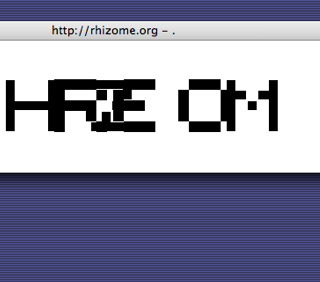Splash art originated in the 1940s in comics, where the term referred to a full page of visuals at the front of a book. Pages were designed to engage the reader's imagination along the lines of the comic's broader concept, while standing independent from the narrative. In the late 1990s, when the widespread use of the application Flash opened up new possibilities for animation and interactive media, the idea of the splash page migrated to web design. Online splash art brought visual excitement to a webpage when low modem speeds made it impractical to post large or moving images amid a site's textual content.
Rhizome introduced splash pages to its web site in 1998 in order to display artwork with greater immediacy....
Rhizome introduced splash pages to its web site in 1998 in order to display artwork with greater immediacy....
Launch Project 
 Jim/Rhizome/Splash/punk, 2001
Jim/Rhizome/Splash/punk, 2001
About
The point of entry to Rhizome provided by this splash page is a button at the lower right corner, adorned with a period. jimpunk often places the minimal punctuation point in the title of his pages; in Jim/Rhizome/Splash/punk the artist inscribes his signature in the connection to Rhizome's web page. The button floats in a field of blue stripes, below a pop-up window where the letters of Rhizome float and flutter beneath the cursor. jimpunk's splash page looks spare in comparison to the rest of the French artist's work, a dense labyrinth of flashing lights, networked rings, and mash-ups that keeps in step with the web's new capabilities.
http://www.jimpunk.net/
http://www.jimpunk.net/